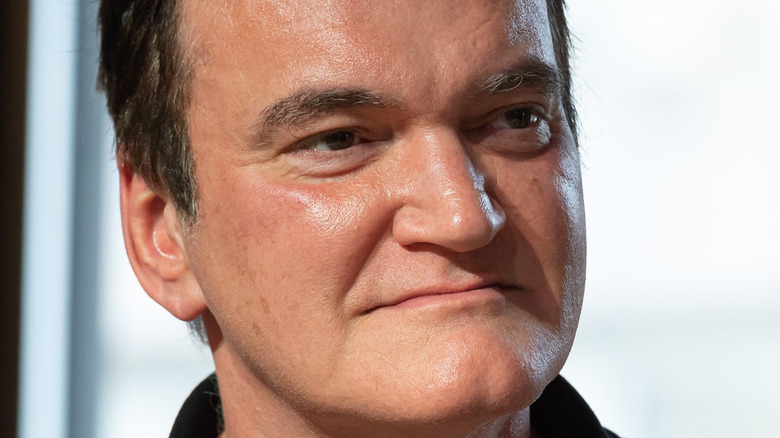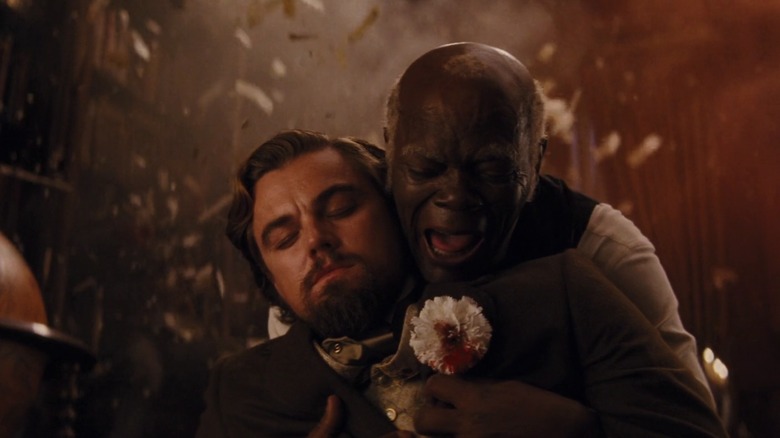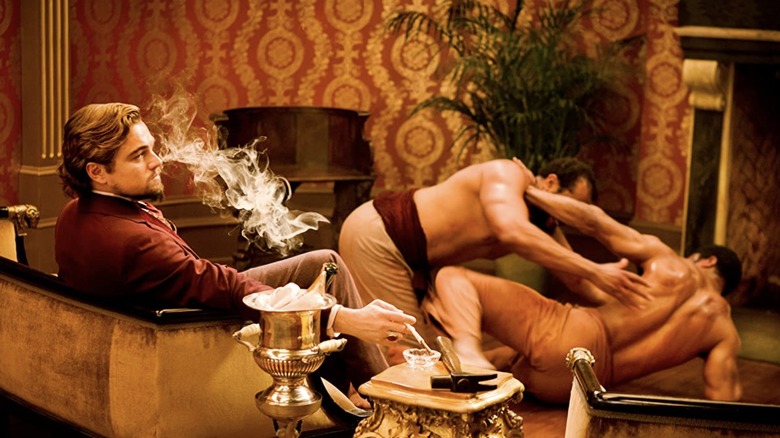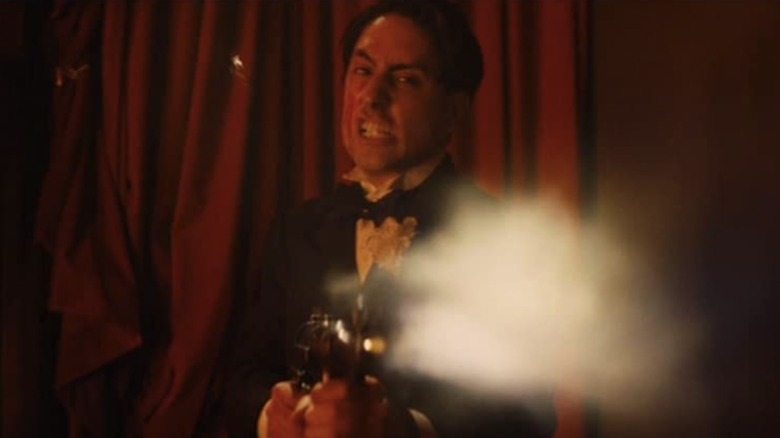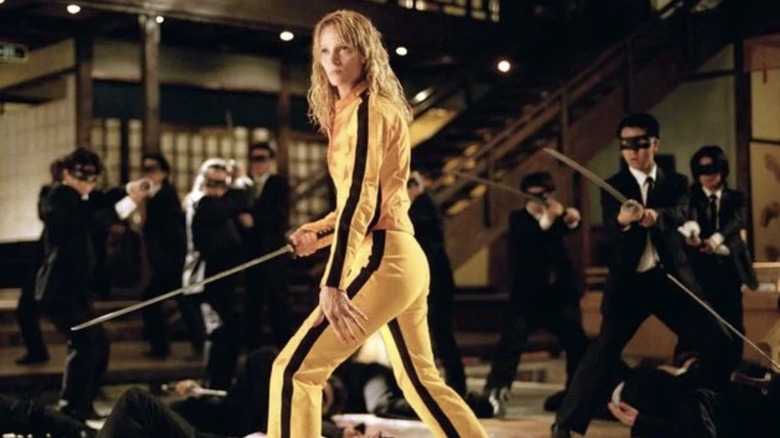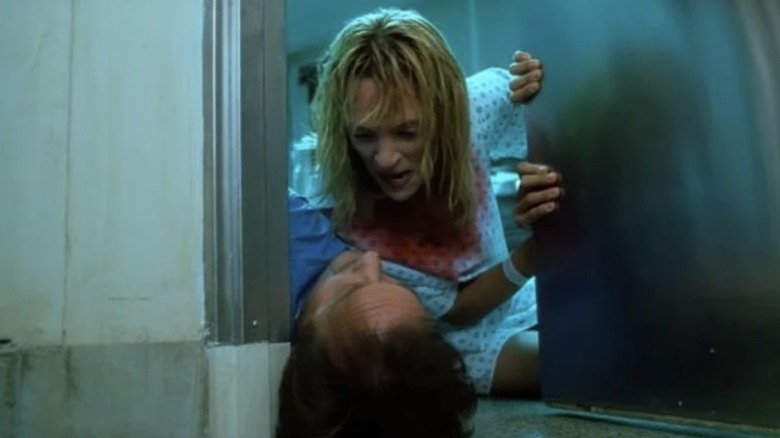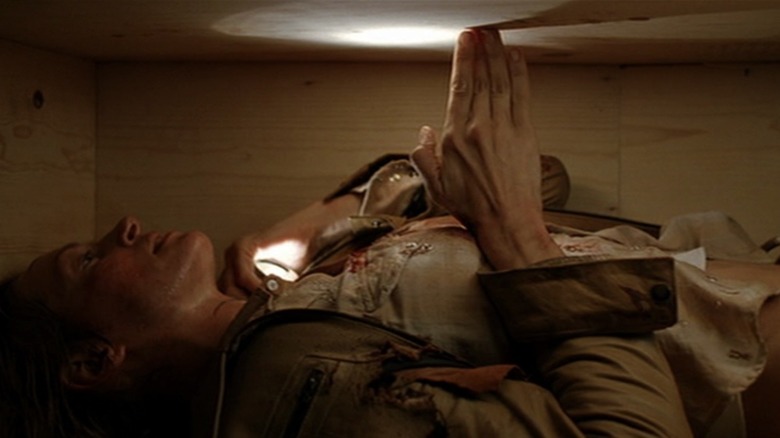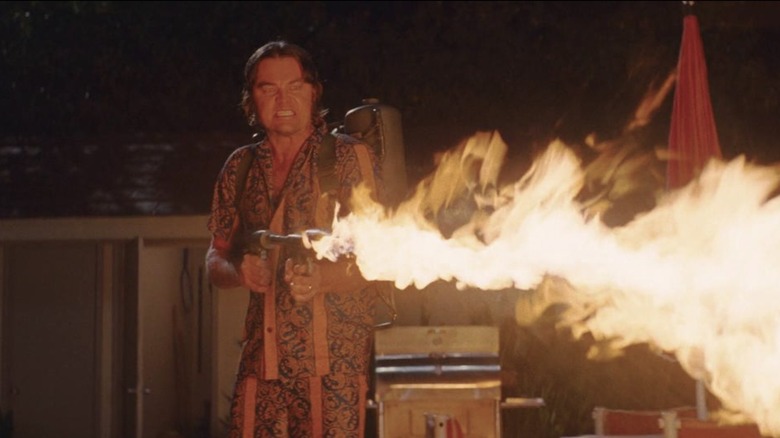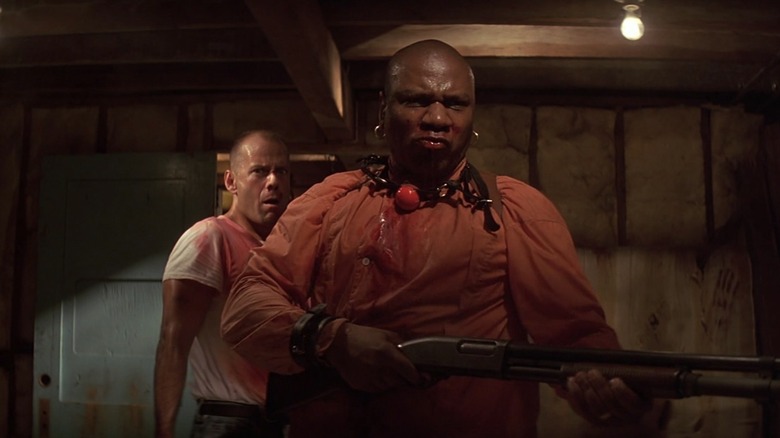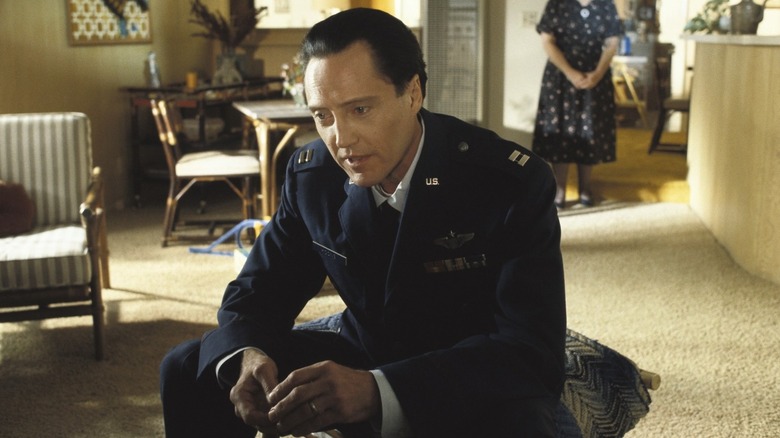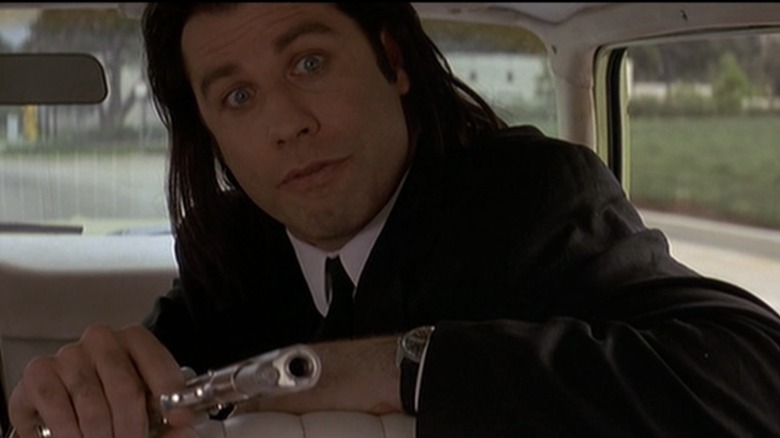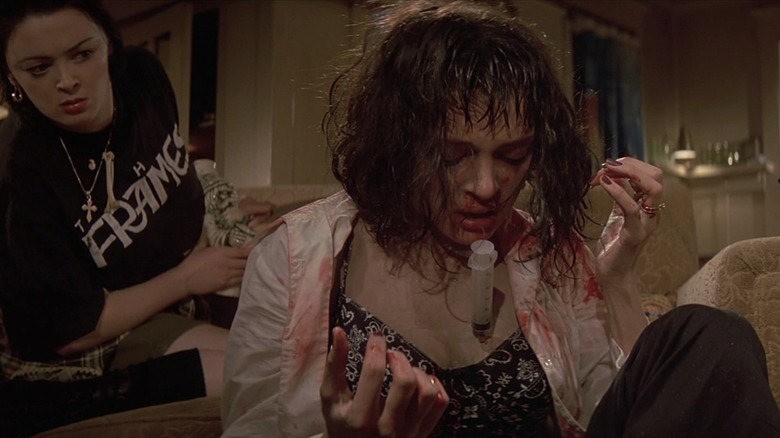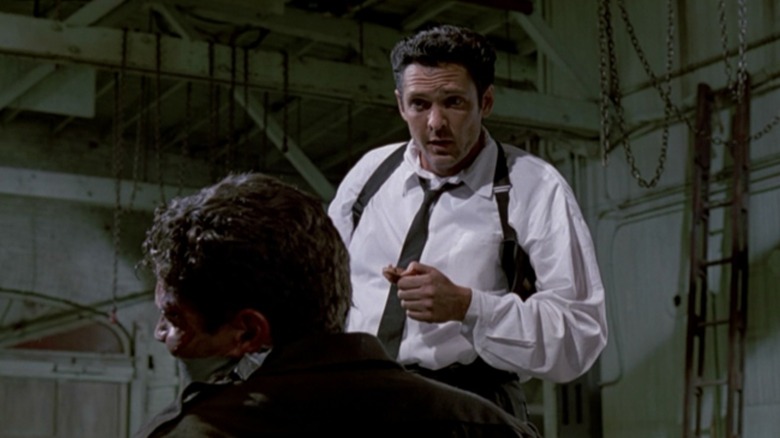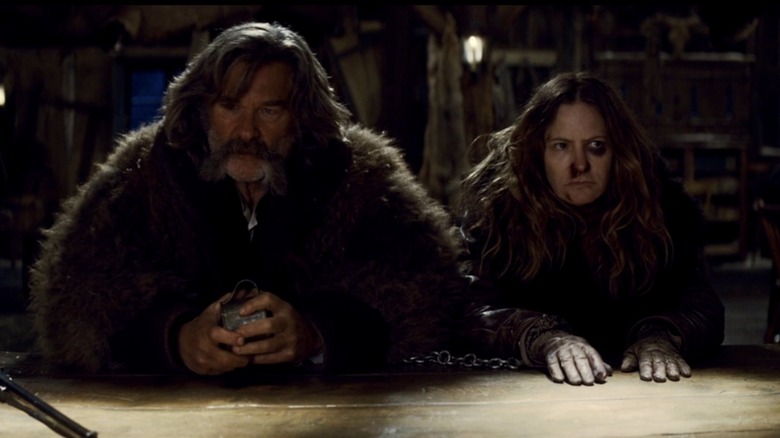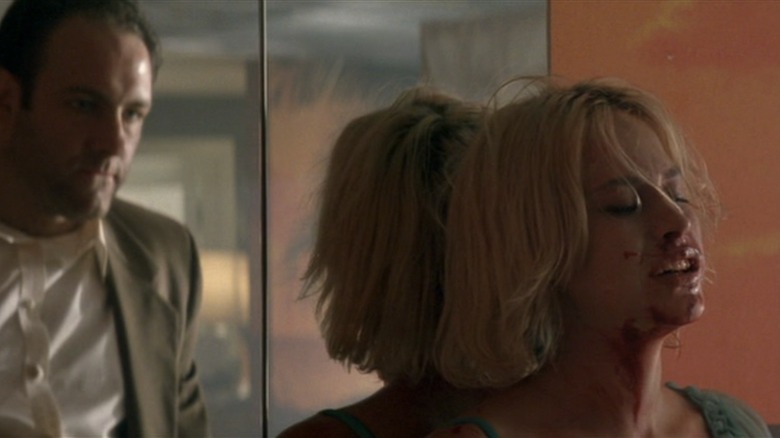These Tarantino Movie Scenes Went Too Far
When Quinten Tarantino burst onto the public's radar in 1992 with his first film, "Reservoir Dogs," it was obvious there was a new auteur filmmaker in town, and he had a style all his own. Two years later, when Tarantino released "Pulp Fiction," he won an Oscar for his screenplay with his writing partner Roger Avary. With his second movie, Tarantino's reputation as a filmmaker with a unique vision was cemented.
Not only did the Academy recognize Tarantino as an influential filmmaker, in 1994, the Oxford English Dictionary added the term "Tarantinoesque" to their dictionary, saying, "Tarantino's films are typically characterized by graphic and stylized violence, non-linear storylines, cineliterate references, satirical themes, and sharp dialogue." His films are also love letters to genre filmmaking. Splashy homages to his favorite movies liberally sprinkled with pop culture references and fictional products like Red Apple cigarettes and Big Kahuna Burger.
Tarantino's special brand of filmmaking is intentionally over-the-top, brash, self-referential, and set in his own alternate reality, where monologues are a normal part of communication and morally gray characters can have a crisis of conscience too. This stylized vision, accompanied by retro soundtracks and excellent original scores, works for Tarantino. His audiences expect this cinematic alchemy, and it's why we watch his darkly comic movies repeatedly. But every once in a while, Tarantino could have benefitted from employing a little restraint.
Django Unchained: Candyland shootout
Quentin Tarantino's 2012 film "Django Unchained" not only scored as a "must-see" movie on Metacritic, but it also won two Oscars. Despite being an excellent film with terrific performances, it has a couple of scenes that simply went too far in entirely different ways. The Candyland shootout is absolutely one of those scenes. The build-up to the shootout during the tense dinner scene and negotiation to purchase Broomhilda (Kerry Washington) was well executed. But once Dr. King Schultz (Christoph Waltz) shoots Calvin Candie (Leonardo DiCaprio) rather than shake his hand, all hell breaks loose, developing into a Tarantino action sequence that could have benefited from just a bit of restraint.
Candie's hired men are used as human shields, being shot repeatedly as Django (Jamie Foxx) uses them for cover. The blood spray is completely over-done, cutting the intensity of the dinner scene with a comic absurdity that just doesn't quite work for some of us. Don't get us wrong, "Django Unchained" is required viewing if you love Tarantino films and the spaghetti Westerns it evokes. We just think if he had dialed back the shootout, even a little, it wouldn't have crossed over from an explosive climax into a ludicrous blood bath.
Django Unchained: The Mandingo fight
Calvin Candie (Leonardo DiCaprio) in "Django Unchained" just might be Quinten Tarantino's most despicable villain. Dr. Schultz (Christoph Waltz) and Django (Jamie Foxx) meet Candie during a Mandingo fight, where two enslaved people fight to the death at the behest of their owners. During this scene, we see Candie's brutality. The elation he experiences while watching these two men brutalize each other is revolting, as are the sound effects of the two men pounding on each other with their bare hands.
The depiction of violence in this scene is far more realistic than Tarantino's typical splashy stylized violence. We hear the crunch as Big Fred (Escalante Lundy) breaks the other man's arm, and then a sickening wet sound as he gouges out his opponents' eyes before putting the injured man out of his misery by bashing his head in with a hammer provided by Candie. This scene goes way too far, playing with both our vision and hearing. The worst part of this scene might be the nonchalant way everyone watches the fight, with either practiced detachment or, in the case of Candie, unadulterated glee.
Inglourious Basterds: Adolf Hitler's assassination
Quentin Tarantino is known for his stylized violence and over-the-top action sequences. Audiences come to the theater expecting completely outrageous death scenes, and Tarantino keeps delivering. Despite lacking realism, his characteristic style typically works to Tarantino's advantage. But the cinema massacre in "Inglourious Basterds" went too far, robbing the film of a scene that could have been truly cathartic for audiences.
Hitler dying at the hands of Jewish-American soldiers or Shosanna (Mélanie Laurent) — the Jewish cinema owner whose family was slaughtered by Nazi soldiers earlier in the film — would have been incredibly satisfying. But having both assassination plots coincide turns Hitler's death into a flamboyant spectacle rather than an emotionally gratifying act of karmic retribution. Either assassination on their own would have been fantastic, but together, it's overkill.
Making a comedy about World War II is tricky and could easily be offensive. Despite the cinema massacre being over-done, Tarantino achieved something many would have expected impossible with "Inglourious Basterds": He made us laugh by finding humor in the eccentric characters, which is the only tangible source of humor in WWII. The entire cast was phenomenal, many speaking multiple languages throughout the film, and Christoph Waltz won an Oscar for his performance as the Nazi Col. Hans Landa.
Kill Bill Vol 1: The Bride battling the Crazy 88s
"Kill Bill Vol. 1" is an incredibly violent film. It is a vengeance story where the Bride (Uma Thurman) awakens from a four-year coma after being shot in the head during her wedding rehearsal. She sets out to kill those who wronged her — the Deadly Viper Assignation Squad, a group of elite killers she was a member of before becoming pregnant with the child of their leader, Bill (David Carradine).
The "Kill Bill" films are a tribute to Tarantino's love of kung fu films, and like his other movies, they are overflowing with gratuitous violence. But there is one scene in Vol. 1 that went a little too far. When the Bride arrives in Tokyo to kill O-Ren Ishii (Lucy Liu), the Bride must battle O-Ren's top lieutenants and the gang, the Crazy 88s, before she can fight O-Ren. While the Bride battles the Crazy 88s, there are so many dismemberments and so much arterial spray that the film becomes too campy.
Tarantino often goes overboard. This is an intentional choice on Tarantino's part, and it is part of the reason we love him. He successfully uses his brand of gratuitous violence for both comic and dramatic effect, but the chopped-off arms and blood spray in "Kill Bill Vol. 1" might have been more effective if he had toned it down and used a modicum of restraint. For example, the scene where the Bride fights in silhouette with a blue background is visually arresting without being ludicrous.
Kill Bill Vol 1: The Bride kills Buck
Awaking from a coma only to discover a man trying to sexually assault you is absolutely awful. The thought that someone like Buck, working as an orderly at the hospital, would prey on helpless women is repugnant. The Bride's flashbacks to Buck assaulting her while in a coma are upsetting, too, as being violated while incapacitated is a special brand of horror for the audience to contemplate while watching this scene in "Kill Bill Vol. 1."
When the Bride kills Buck, he gets what he deserves, but the way she kills him — slamming the door with his head wedged in the doorjamb — is totally gruesome despite the lack of blood. It also shows us how resourceful of a killer the Bride is. Despite not having the use of her legs and having just awoken from a coma, she can still kill two men by catching them off guard and using the tools she has at her disposal. This scene is absolutely chilling.
If you or anyone you know has been a victim of sexual assault, help is available. Visit the Rape, Abuse & Incest National Network website or contact RAINN's National Helpline at 1-800-656-HOPE (4673).
Kill Bill Vol 2: Budd buries the Bride alive
In "Kill Bill Vol. 2," the scene that went too far for some of us wasn't even one of the more violent scenes in the film. When Budd buries the Bride alive, Tarantino preys on the very human fear of being trapped in small spaces, eliciting the discomfort of claustrophobia in the audience and in the actress who had to film the scene. Perhaps we have such a powerful reaction to this scene because Uma Thurman's genuine fear is palpable. Thurman told John Millar in an interview with the Daily Record, "It was horrific. ... It wasn't so bad in some of the side shots because the coffin was open then, but there are a number of times when I was inside, and they had it closed." She added: "Coming through the soil was also horrific."
This live burial scene went too far for some audience members, too, because it pulled them out of the story and made them contemplate if it's even possible to dig out of a grave as the Bride did. This complaint even spawned a Reddit thread, with one person saying the burial scene ruined the movie. While this complaint is valid — the scene isn't realistic — we don't think most people watch Tarantino films looking for reality. We watch Tarantino because we enjoy his cinematic swagger — something he gave us in spades in "Kill Bill Vol. 2."
Once Upon a Time in Hollywood: Rick and Cliff kill the Manson Family
"Once Upon a Time in Hollywood" is arguably one of Quentin Tarantino's least violent films ... until the Manson family killers attack Rick Dalton's (Leonardo DiCaprio) home instead of Sharon Tate's (Margot Robbie). When Tex (Austin Butler) bursts through the front door armed with a revolver accompanied by two hippie chicks carrying knives, they surprise Cliff Booth (Brad Pitt) and his pitbull Brandy, who are spending the night at Rick's house after tripping on acid.
After asking if the intruders are real, Cliff unleashes shocking violence. Cliff sics Brandy on Tex before throwing a can of dog food at the brunette's face, smashing her nose. Brandy then attacks the brunette while Cliff kills Tex with his bare hands. Cliff then moves on to the redhead, smashing her face into the fireplace mantle, obliterating her bone structure entirely. After wreaking violence, Cliff promptly passes out as the brunette escapes Brandy's clutches. The Brunette then runs into the backyard, screaming and in pain.
Rick has been studying his lines with headphones on and is completely unaware of what's going on inside. Once Rick understands his home is under siege, he grabs the flamethrower he brought home from set, unleashing flames on the final intruder. She screams as she burns to death before sinking under the surface of the swimming pool. This last bit with the flamethrower was completely over-the-top and ludicrous. But audiences walk into Tarantino's film expecting to see outrageous violence with a good soundtrack, and he hasn't let us down yet.
Pulp Fiction: Butch saves Marsellus
Writer/director Quentin Tarantino not only became a household name because of his 1994 film "Pulp Fiction," but he also won an Oscar. It became one of the most influential films of the '90s, snagging a "fresh" rating on Rotten Tomatoes and a "must-see" score on Metacritic. To this day, Tarantino's second film is still his highest-rated and most loved movie, filled with iconic scenes, snappy dialogue, and the gratuitous violence we expect of this auteur filmmaker.
Although Tarantino's films have been criticized for their graphic violence, the popularity of his films has proven that audiences love his brand of noir meets dark comedy. Despite audiences eating up Tarantino's twisted visions, "Pulp Fiction" has a series of scenes that went too far. The scene where Butch saves Marsellus from the hillbillies who are assaulting him is one of those scenes. After being held captive, Butch (Bruce Willis) escapes his bonds. As Butch approaches the door, he has a crisis of conscience, going back for Marsellus (Ving Rhames) after selecting his weapon of choice.
We rarely see men as the victims of sexual assault, making this scene especially disturbing. Tarantino pushing this boundary makes some audience members very uncomfortable. Sexual assault is never funny, and Tarantino didn't play this scene as comical — he practiced uncharacteristic restraint, never allowing the sequence to devolve into the absurd or farcical. Despite the respect Tarantino practiced, it is still an exceedingly tough scene to watch.
If you or anyone you know has been a victim of sexual assault, help is available. Visit the Rape, Abuse & Incest National Network website or contact RAINN's National Helpline at 1-800-656-HOPE (4673).
Pulp Fiction: Christopher Walken's gold watch monologue
Christopher Walken's gold watch monologue is another scene in "Pulp Fiction" that went a bit too far. One might think the complaint could be solely based upon the scene being gross because of where Captain Koons (Walken) hid the watch while in a POW camp during the Vietnam War. But the hiding place is actually what brings this scene back to the realm of comedy from the brink of tragedy. Listening to Koons share Butch's family history through the watch is a grim reminder of the multiple generations of men who went off to war and the ones who never came home. The scene stands out in stark relief from most of Tarantino's other writing because of how rooted in reality and history it is. Most of us watch Tarantino films because we are drawn to the darkly funny, fictional world he creates on the screen, but this scene dangerously flirted with bringing us back to a somber reality.
Pulp Fiction: I shot Marvin in the face!
Vincent Vega (John Travolta) accidentally shoots Marvin in the face during a philosophical conversation with Jules Winnfield (Samuel L. Jackson) about miraculously escaping injury during a shootout. It is one of the more visually disgusting scenes in "Pulp Fiction," and Vincent and Jules' reaction to the accidental death is more than a little troubling. They don't express remorse about Marvin's death — they just argue about where they can clean the car away from prying eyes. This is one of the more shocking death scenes in the film because it's so unexpected.
The car interior painted in blood is pretty bad, but the absolute worst part of this scene is when you notice Marvin's brains clinging to Jules' hair while he is talking on the phone. Yuck! In an interview, Travolta talked about how he improvised and asked to change his line to inject it with humor by down-playing what Vega had just done. Travolta was right! Somehow, saying, "Oh, man. I shot Marvin in the face!" rather than acknowledging Vega had just blown Marvin's head off makes the scene absurdly funny. Nevertheless, it's still visually revolting and goes too far for those of us with a weak stomach.
Pulp Fiction: Mia's overdose
One of the most intense and uncomfortable scenes in "Pulp Fiction" is when Mia Wallace (Uma Thurman) overdoses on the heroin she finds in Vincent's coat pocket, believing it to be cocaine. When Vincent comes back into the living room and finds Mia unconscious with a bloody nose, his fear is palpable as he races against the clock, trying to save Mia before she dies. Once Vincent arrives at his dealer's house, the frustration, anger, and fear only escalate as Vincent explains to Lance (Eric Stoltz) who her husband is and the trouble they will be in if she dies.
Unlike much of Tarantino's graphic violence, this scene feels very real, eliciting panic in the audience. We can see the stress sweat glistening on Lance and Vincent's faces as they argue over who will give Mia the life-saving shot of adrenaline directly into her heart. This scene is visceral and shocking. Film historian Leonard Maltin said (per USA Today), "Once you see that scene, you can never unsee it. It packs one hell of a punch and was so unprecedented." This scene feels unbearably authentic and goes too far for some of us. The sound of the hypodermic needle popping through Mia's breast place is especially awful.
If you or anyone you know is struggling with addiction issues, help is available. Visit the Substance Abuse and Mental Health Services Administration website or contact SAMHSA's National Helpline at 1-800-662-HELP (4357).
Reservoir Dogs: Mr. Blonde torturing Marvin Nash
Writer/director Quentin Tarantino's debut film "Reservoir Dogs" boldly announced there was a fresh voice in filmmaking back in 1992. Fans went crazy for the movie and loved the snappy dialogue and witty monologues, which have become a hallmark of Tarantino films. But while Tarantino is known for excessive violence, audiences who went to see his first movie probably didn't know what they were getting themselves into.
"Reservoir Dogs" begins with a diner scene before the group makes a failed robbery attempt off-screen. Tarantino cuts from the iconic intro sequence — the group walking in slow-motion with their skinny black ties and suits — directly to the aftermath of the botched robbery. Mr. White (Harvey Keitel) drives Mr. Orange (Tim Roth), who is bleeding profusely in the car's backseat, to a hideout location. The film continues with tense dialogue and flashbacks, but the violence happens off-screen.
Until we come to the infamous torture scene, where Mr. Blonde cuts officer Marvin Nash's ear off while dancing to the song "stuck in the middle with you." The upbeat music and the bounce in Mr. Blonde's step, juxtaposed with the brutal violence, are disturbing. Mr. Blonde relishing officer Nash's fear is sickening, proving Mr. Blonde to be a sociopath. The tense scene ends suddenly as gunshots ring out and strike Mr. Blonde moments before he sets Nash on fire, and it is a tremendous relief.
The Hateful Eight: the poisoning scene
"The Hateful Eight" was Tarantino's second love letter to spaghetti Westerns, once again featuring bounty hunters as the central characters of the film. When bounty hunter Major Marquis Warren (Samuel L. Jackson) becomes stranded with three corpses of wanted men on a snowy mountain pass and no horse, he hitches a stagecoach ride with bounty hunter John Ruth (Kurt Russell) and his prisoner Daisy Domergue (Jennifer Jason Leigh). After picking up a fourth stranded traveler, Sheriff Chris Mannix (Walton Goggins), the stagecoach stops to wait out a blizzard at Minnie's Haberdashery with a group of questionable men.
In this film, Tarantino ratchets up the tension by employing snide remarks and colorful dialogue rather than abundant violence. Until we reach the poisoned coffee scene, where the violent climax of the film begins. It is in this scene that John Ruth's suspicions that someone in the sanctuary is in cahoots to free Daisy are confirmed after he vomits blood and surmises that someone poisoned the coffee when the stagecoach driver falls down dead. The look of surprise on John's face as blood spews from his mouth and Daisy says, "When you get to hell, John, tell em Daisy sent ya," is affecting and disgusting. When Daisy shoots John point-blank, spraying his blood on her face, the restraint Tarantino employed throughout the film breaks loose, developing into a deadly blood bath that goes too far, leaving the haberdashery littered with dead bodies.
True Romance: Alabama's motel brawl
Quinten Tarantino wrote the 1993 crime movie "True Romance," but Tony Scott directed the film. After Clarence (Christian Slater) — a kung fu movie aficionado who works at a comic book store — meets Alabama (Patricia Arquette) at the movie theater on his birthday, they fall in love. Despite learning that Alabama is a sex worker and was paid to seduce Clarence, the two get married at the courthouse. But when Clarence goes to tell Alabama's pimp, Drexl (Gary Oldman), that she won't be coming back, things go sideways. Clarence winds up killing Drexl and taking a suitcase of cocaine, thinking it contains Alabama's belongings. Despite being tense and violent, this is not the scene in the film that goes too far.
After killing Drexl, the couple skips town and heads for California, where they hope to sell the cocaine in Hollywood. Unfortunately, the mob is in hot pursuit of their cocaine, and things come to a head when Virgil (James Gandolfini) confronts Alabama in a motel room. The motel brawl is, without a doubt, the most intense scene in "True Romance." Watching Virgil brutally beat Alabama while she refuses to say anything is not for the faint of heart. The violence in this scene is very realistic and makes it so difficult to watch. Alabama goes somewhere primal while fighting for her life, screaming like an animal after she shoots Virgil.
